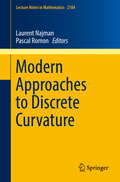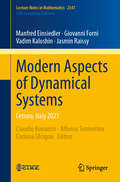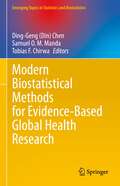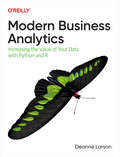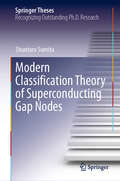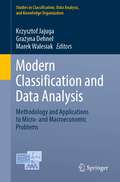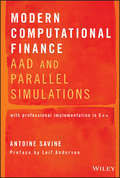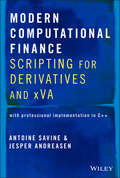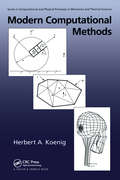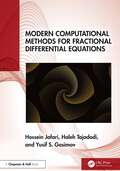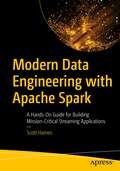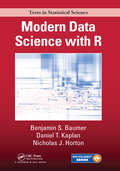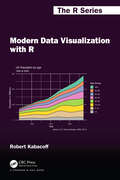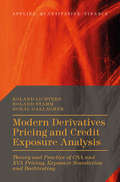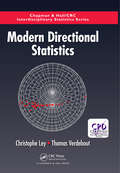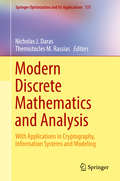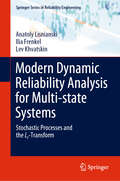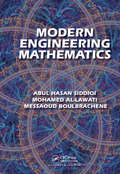- Table View
- List View
Modern Approaches to Discrete Curvature
by Laurent Najman Pascal RomonThis book provides a valuable glimpse into discrete curvature, a rich new field of research which blends discrete mathematics, differential geometry, probability and computer graphics. It includes a vast collection of ideas and tools which will offer something new to all interested readers. Discrete geometry has arisen as much as a theoretical development as in response to unforeseen challenges coming from applications. Discrete and continuous geometries have turned out to be intimately connected. Discrete curvature is the key concept connecting them through many bridges in numerous fields: metric spaces, Riemannian and Euclidean geometries, geometric measure theory, topology, partial differential equations, calculus of variations, gradient flows, asymptotic analysis, probability, harmonic analysis, graph theory, etc. In spite of its crucial importance both in theoretical mathematics and in applications, up to now, almost no books have provided a coherent outlook on this emerging field.
Modern Aspects of Dynamical Systems: Cetraro, Italy 2021 (Lecture Notes in Mathematics #2347)
by Manfred Einsiedler Vadim Kaloshin Giovanni Forni Jasmin RaissyThis book provides an overview of recent advances in the theory of dynamical systems, with a particular emphasis on their connections to other areas of mathematical research, including number theory, geometry, mathematical physics, complex analysis, and celestial mechanics. Compiling the lecture notes from some of the contributions presented at the C.I.M.E. school "Modern Aspects of Dynamical Systems" held in Cetraro in August 2021, the contributions are the following: “Homogeneous dynamics and Diophantine problems” by Manfred Einsiedler, “Effective ergodic theory for translation flow” by Giovanni Forni, “Integrability and rigidity for convex billiards” by Vadim Kaloshin, “Holomorphic dynamics” by Jasmin Raissy and “Exponentially small phenomena and its role in the dynamics” by Tere Martinez-Seara. These notes are suitable for graduate students and young researchers interested in an introduction to some of the modern research areas within the field of dynamical systems.
Modern Biostatistical Methods for Evidence-Based Global Health Research (Emerging Topics in Statistics and Biostatistics)
by Ding-Geng Din Chen Samuel O. M. Manda Tobias F. ChirwaThis book provides an overview of the emerging topics in biostatistical theories and methods through their applications to evidence-based global health research and decision-making. It brings together some of the top scholars engaged in biostatistical method development on global health to highlight and describe recent advances in evidence-based global health applications. The volume is composed of five main parts: data harmonization and analysis; systematic review and statistical meta-analysis; spatial-temporal modeling and disease mapping; Bayesian statistical modeling; and statistical methods for longitudinal data or survival data. It is designed to be illuminating and valuable to both expert biostatisticians and to health researchers engaged in methodological applications in evidence-based global health research. It is particularly relevant to countries where global health research is being rigorously conducted.
Modern Business Analytics: Increasing the Value of Your Data with Python and R
by Deanne LarsonDeriving business value from analytics is a challenging process. Turning data into information requires a business analyst who is adept at multiple technologies including databases, programming tools, and commercial analytics tools. This practical guide shows programmers who understand analysis concepts how to build the skills necessary to achieve business value.Author Deanne Larson, data science practitioner and academic, helps you bridge the technical and business worlds to meet these requirements. You'll focus on developing these skills with R and Python using real-world examples. You'll also learn how to leverage methodologies for successful delivery. Learning methodology combined with open source tools is key to delivering successful business analytics and value.This book shows you how to:Apply business analytics methodologies to achieve successful resultsCleanse and transform data using R and PythonUse R and Python to complete exploratory data analysisCreate predictive models to solve business problems in R and PythonUse Python, R, and business analytics tools to handle large volumes of dataCommit code to GitHub to collaborate with data engineers and data scientistsMeasure success in business analytics
Modern Calculus and Analytic Geometry
by Richard A. SilvermanA self-contained text for an introductory course, this volume places strong emphasis on physical applications. Key elements of differential equations and linear algebra are introduced early and are consistently referenced, all theorems are proved using elementary methods, and numerous worked-out examples appear throughout. The highly readable text approaches calculus from the student's viewpoint and points out potential stumbling blocks before they develop. A collection of more than 1,600 problems ranges from exercise material to exploration of new points of theory -- many of the answers are found at the end of the book; some of them worked out fully so that the entire process can be followed. This well-organized, unified text is copiously illustrated, amply cross-referenced, and fully indexed.
Modern Classification Theory of Superconducting Gap Nodes (Springer Theses)
by Shuntaro SumitaThis book puts forward a modern classification theory for superconducting gap nodes, whose structures can be observed by experiments and are essential for understanding unconventional superconductivity. In the first part of the book, the classification method, based on group theory and K theory, is introduced in a step-by-step, pedagogical way. In turn, the latter part presents comprehensive classification tables, which include various nontrivial gap (node) structures, which are not predicted by the Sigrist-Ueda method, but are by the new method. The results obtained here show that crystal symmetry and/or angular momentum impose critical constraints on the superconducting gap structures. Lastly, the book lists a range of candidate superconductors for the nontrivial gap nodes. The classification methods and tables presented here offer an essential basis for further investigations into unconventional superconductivity. They indicate that previous experimental studies should be reinterpreted, while future experiments should reflect the new excitation spectrum.
Modern Classification and Data Analysis: Methodology and Applications to Micro- and Macroeconomic Problems (Studies in Classification, Data Analysis, and Knowledge Organization)
by Krzysztof Jajuga Marek Walesiak Grażyna DehnelThis volume presents a selection of peer-reviewed papers that address the latest developments in the methodology and applications of data analysis and classification tools to micro- and macroeconomic problems. The contributions were originally presented at the 30th Conference of the Section on Classification and Data Analysis of the Polish Statistical Association, SKAD 2021, held online in Poznań, Poland, September 8–10, 2021. Providing a balance between methodological and empirical studies, and covering a wide range of topics, the book is divided into five parts focusing on methods and applications in finance, economics, social issues and to COVID-19 data. The book is aimed at a wide audience, including researchers at universities and research institutions, PhD students, as well as practitioners, data scientists and employees in public statistical institutions.
Modern Computational Finance: AAD and Parallel Simulations
by Antoine Savine Leif AndersenArguably the strongest addition to numerical finance of the past decade, Algorithmic Adjoint Differentiation (AAD) is the technology implemented in modern financial software to produce thousands of accurate risk sensitivities, within seconds, on light hardware.AAD recently became a centerpiece of modern financial systems and a key skill for all quantitative analysts, developers, risk professionals or anyone involved with derivatives. It is increasingly taught in Masters and PhD programs in finance.Danske Bank's wide scale implementation of AAD in its production and regulatory systems won the In-House System of the Year 2015 Risk award. The Modern Computational Finance books, written by three of the very people who designed Danske Bank's systems, offer a unique insight into the modern implementation of financial models. The volumes combine financial modelling, mathematics and programming to resolve real life financial problems and produce effective derivatives software.This volume is a complete, self-contained learning reference for AAD, and its application in finance. AAD is explained in deep detail throughout chapters that gently lead readers from the theoretical foundations to the most delicate areas of an efficient implementation, such as memory management, parallel implementation and acceleration with expression templates.The book comes with professional source code in C++, including an efficient, up to date implementation of AAD and a generic parallel simulation library. Modern C++, high performance parallel programming and interfacing C++ with Excel are also covered. The book builds the code step-by-step, while the code illustrates the concepts and notions developed in the book.
Modern Computational Finance: Scripting for Derivatives and xVA
by Antoine Savine Jesper AndreasenAn incisive and essential guide to building a complete system for derivative scripting In Volume 2 of Modern Computational Finance Scripting for Derivatives and xVA, quantitative finance experts and practitioners Drs. Antoine Savine and Jesper Andreasen deliver an indispensable and insightful roadmap to the interrogation, aggregation, and manipulation of cash-flows in a variety of ways. The book demonstrates how to facilitate portfolio-wide risk assessment and regulatory calculations (like xVA). Complete with a professional scripting library written in modern C++, this stand-alone volume walks readers through the construction of a comprehensive risk and valuation tool. This essential book also offers: Effective strategies for improving scripting libraries, from basic examples—like support for dates and vectors—to advanced improvements, including American Monte Carlo techniques Exploration of the concepts of fuzzy logic and risk sensitivities, including support for smoothing and condition domains Discussion of the application of scripting to xVA, complete with a full treatment of branching Perfect for quantitative analysts, risk professionals, system developers, derivatives traders, and financial analysts, Modern Computational Finance Scripting for Derivatives and xVA: Volume 2 is also a must-read resource for students and teachers in master’s and PhD finance programs.
Modern Computational Methods
by Herbert KoenigThis book is an introduction to computational mechanics, proceeding from basic computational tools to advanced computational procedures and applications. Emphasis is placed on the numerical techniques and how they form the bases for algorithms. Numerous worked examples in structural mechanics, heat transfer, fluid flow, and biomechanics are given with the numerical codes to illustrate how the methods are applied. A concluding section addresses advanced applications in such areas as finite volume methods and biomechanics.
Modern Computational Methods for Fractional Differential Equations
by Hossein Jafari Haleh Tajadodi Yusif S. GasimovModern Computational Methods for Fractional Differential Equations provides a comprehensive introduction to the fundamentals of fractional calculus. Covering a range of analytical and numerical methods specifically designed for fractional calculus problems, the book explains the step-by-step implementation and computational aspects of these methods. Readers of this book should feel empowered to effectively apply analytical and numerical techniques to solve fractional calculus problems.Features· Practical examples and case studies· Suitable material for professional and postgraduate researchers· Numerous interesting and novel problems.
Modern Computer Algebra
by Joachim Von Zur Gathen Jürgen GerhardComputer algebra systems are gaining more and more importance in all areas of science and engineering. This textbook gives a thorough introduction to the subject, which is the basis of the mathematical engine in computer algebra systems. It is designed to accompany one- or two-semester courses for advanced undergraduate or graduate students in computer science or mathematics. However its comprehensiveness and authority will mean it will be an essential reference also for professionals in the area. Special features include: detailed study of algorithmics including time analysis; implementation reports on several topics; complete proofs of the mathematical underpinnings; a wide variety of applications (including in chemistry, coding theory, cryptography, and the design of calendars and musical scales). Some of this material has never appeared before in book form. Finally, a great deal of historical information and illustration is included.
Modern Cryptography: Applied Mathematics for Encryption and Information Security
by William EasttomThis textbook is a practical yet in depth guide to cryptography and its principles and practices. The book places cryptography in real-world security situations using the hands-on information contained throughout the chapters. Prolific author Dr. Chuck Easttom lays out essential math skills and fully explains how to implement cryptographic algorithms in today's data protection landscape. Readers learn and test out how to use ciphers and hashes, generate random keys, handle VPN and Wi-Fi security, and encrypt VoIP, Email, and Web communications. The book also covers cryptanalysis, steganography, and cryptographic backdoors and includes a description of quantum computing and its impact on cryptography. This book is meant for those without a strong mathematics background _ only just enough math to understand the algorithms given. The book contains a slide presentation, questions and answers, and exercises throughout. Presents a comprehensive coverage of cryptography in an approachable format;Covers the basic math needed for cryptography _ number theory, discrete math, and algebra (abstract and linear);Includes a full suite of classroom materials including exercises, Q&A, and examples.
Modern Cryptography: Applied Mathematics for Encryption and Information Security
by William EasttomThis expanded textbook, now in its second edition, is a practical yet in depth guide to cryptography and its principles and practices. Now featuring a new section on quantum resistant cryptography in addition to expanded and revised content throughout, the book continues to place cryptography in real-world security situations using the hands-on information contained throughout the chapters. Prolific author Dr. Chuck Easttom lays out essential math skills and fully explains how to implement cryptographic algorithms in today's data protection landscape. Readers learn and test out how to use ciphers and hashes, generate random keys, handle VPN and Wi-Fi security, and encrypt VoIP, Email, and Web communications. The book also covers cryptanalysis, steganography, and cryptographic backdoors and includes a description of quantum computing and its impact on cryptography. This book is meant for those without a strong mathematics background with only just enough math to understand the algorithms given. The book contains a slide presentation, questions and answers, and exercises throughout.Presents new and updated coverage of cryptography including new content on quantum resistant cryptography;Covers the basic math needed for cryptography - number theory, discrete math, and algebra (abstract and linear);Includes a full suite of classroom materials including exercises, Q&A, and examples.
Modern Data Engineering with Apache Spark: A Hands-On Guide for Building Mission-Critical Streaming Applications
by Scott HainesLeverage Apache Spark within a modern data engineering ecosystem. This hands-on guide will teach you how to write fully functional applications, follow industry best practices, and learn the rationale behind these decisions. With Apache Spark as the foundation, you will follow a step-by-step journey beginning with the basics of data ingestion, processing, and transformation, and ending up with an entire local data platform running Apache Spark, Apache Zeppelin, Apache Kafka, Redis, MySQL, Minio (S3), and Apache Airflow.Apache Spark applications solve a wide range of data problems from traditional data loading and processing to rich SQL-based analysis as well as complex machine learning workloads and even near real-time processing of streaming data. Spark fits well as a central foundation for any data engineering workload. This book will teach you to write interactive Spark applications using Apache Zeppelin notebooks, write and compile reusable applications and modules, and fully test both batch and streaming. You will also learn to containerize your applications using Docker and run and deploy your Spark applications using a variety of tools such as Apache Airflow, Docker and Kubernetes.Reading this book will empower you to take advantage of Apache Spark to optimize your data pipelines and teach you to craft modular and testable Spark applications. You will create and deploy mission-critical streaming spark applications in a low-stress environment that paves the way for your own path to production. What You Will LearnSimplify data transformation with Spark Pipelines and Spark SQLBridge data engineering with machine learningArchitect modular data pipeline applications Build reusable application components and libraries Containerize your Spark applications for consistency and reliabilityUse Docker and Kubernetes to deploy your Spark applicationsSpeed up application experimentation using Apache Zeppelin and Docker Understand serializable structured data and data contracts Harness effective strategies for optimizing data in your data lakes Build end-to-end Spark structured streaming applications using Redis and Apache Kafka Embrace testing for your batch and streaming applications Deploy and monitor your Spark applications Who This Book Is ForProfessional software engineers who want to take their current skills and apply them to new and exciting opportunities within the data ecosystem, practicing data engineers who are looking for a guiding light while traversing the many challenges of moving from batch to streaming modes, data architects who wish to provide clear and concise direction for how best to harness and use Apache Spark within their organization, and those interested in the ins and outs of becoming a modern data engineer in today's fast-paced and data-hungry world
Modern Data Mining Algorithms in C++ and CUDA C: Recent Developments in Feature Extraction and Selection Algorithms for Data Science
by Timothy MastersDiscover a variety of data-mining algorithms that are useful for selecting small sets of important features from among unwieldy masses of candidates, or extracting useful features from measured variables. As a serious data miner you will often be faced with thousands of candidate features for your prediction or classification application, with most of the features being of little or no value. You’ll know that many of these features may be useful only in combination with certain other features while being practically worthless alone or in combination with most others. Some features may have enormous predictive power, but only within a small, specialized area of the feature space. The problems that plague modern data miners are endless. This book helps you solve this problem by presenting modern feature selection techniques and the code to implement them. Some of these techniques are:Forward selection component analysis Local feature selection Linking features and a target with a hidden Markov model Improvements on traditional stepwise selection Nominal-to-ordinal conversion All algorithms are intuitively justified and supported by the relevant equations and explanatory material. The author also presents and explains complete, highly commented source code. The example code is in C++ and CUDA C but Python or other code can be substituted; the algorithm is important, not the code that's used to write it. What You Will Learn Combine principal component analysis with forward and backward stepwise selection to identify a compact subset of a large collection of variables that captures the maximum possible variation within the entire set. Identify features that may have predictive power over only a small subset of the feature domain. Such features can be profitably used by modern predictive models but may be missed by other feature selection methods. Find an underlying hidden Markov model that controls the distributions of feature variables and the target simultaneously. The memory inherent in this method is especially valuable in high-noise applications such as prediction of financial markets. Improve traditional stepwise selection in three ways: examine a collection of 'best-so-far' feature sets; test candidate features for inclusion with cross validation to automatically and effectively limit model complexity; and at each step estimate the probability that our results so far could be just the product of random good luck. We also estimate the probability that the improvement obtained by adding a new variable could have been just good luck. Take a potentially valuable nominal variable (a category or class membership) that is unsuitable for input to a prediction model, and assign to each category a sensible numeric value that can be used as a model input. Who This Book Is For Intermediate to advanced data science programmers and analysts. C++ and CUDA C experience is highly recommended. However, this book can be used as a framework using other languages such as Python.
Modern Data Science with R (Chapman & Hall/CRC Texts in Statistical Science)
by Benjamin S. Baumer Daniel T. Kaplan Nicholas J. HortonModern Data Science with R is a comprehensive data science textbook for undergraduates that incorporates statistical and computational thinking to solve real-world problems with data. Rather than focus exclusively on case studies or programming syntax, this book illustrates how statistical programming in the state-of-the-art R/RStudio computing environment can be leveraged to extract meaningful information from a variety of data in the service of addressing compelling statistical questions. <P><P> Contemporary data science requires a tight integration of knowledge from statistics, computer science, mathematics, and a domain of application. This book will help readers with some background in statistics and modest prior experience with coding develop and practice the appropriate skills to tackle complex data science projects. The book features a number of exercises and has a flexible organization conducive to teaching a variety of semester courses.
Modern Data Science with R (Chapman & Hall/CRC Texts in Statistical Science)
by Benjamin S. Baumer Daniel T. Kaplan Nicholas J. HortonFrom a review of the first edition: "Modern Data Science with R… is rich with examples and is guided by a strong narrative voice. What’s more, it presents an organizing framework that makes a convincing argument that data science is a course distinct from applied statistics" (The American Statistician).Modern Data Science with R is a comprehensive data science textbook for undergraduates that incorporates statistical and computational thinking to solve real-world data problems. Rather than focus exclusively on case studies or programming syntax, this book illustrates how statistical programming in the state-of-the-art R/RStudio computing environment can be leveraged to extract meaningful information from a variety of data in the service of addressing compelling questions.The second edition is updated to reflect the growing influence of the tidyverse set of packages. All code in the book has been revised and styled to be more readable and easier to understand. New functionality from packages like sf, purrr, tidymodels, and tidytext is now integrated into the text. All chapters have been revised, and several have been split, re-organized, or re-imagined to meet the shifting landscape of best practice.
Modern Data Visualization with R (Chapman & Hall/CRC The R Series)
by Robert KabacoffModern Data Visualization with R describes the many ways that raw and summary data can be turned into visualizations that convey meaningful insights. It starts with basic graphs such as bar charts, scatter plots, and line charts, but progresses to less well-known visualizations such as tree maps, alluvial plots, radar charts, mosaic plots, effects plots, correlation plots, biplots, and the mapping of geographic data. Both static and interactive graphics are described and the use of color, shape, shading, grouping, annotation, and animations are covered in detail. The book moves from a default look and feel for graphs, to graphs with customized colors, fonts, legends, annotations, and organizational themes.Features Contains a wide breadth of graph types including newer and less well-known approaches Connects each graph type to the characteristics of the data and the goals of the analysis Moves the reader from simple graphs describing one variable to building visualizations that describe complex relationships among many variables Provides newer approaches to creating interactive web graphics via JavaScript libraries Details how to customize each graph type to meet users’ needs and those of their audiences Gives methods for creating visualizations that are publication ready for print (in color or black and white) and the web Suggests best practices Offers examples from a wide variety of fields The book is written for those new to data analysis as well as the seasoned data scientist. It can be used for both teaching and research, and will particularly appeal to anyone who needs to describe data visually and wants to find and emulate the most appropriate method quickly. The reader should have some basic coding experience, but expertise in R is not required. Some of the later chapters (e.g., visualizing statistical models) assume exposure to statistical inference at the level of analysis of variance and regression.
Modern Derivatives Pricing and Credit Exposure Analysis: Theory and Practice of CSA and XVA Pricing, Exposure Simulation and Backtesting (Applied Quantitative Finance)
by Roland Stamm Roland Lichters Donal GallagherThis book provides a comprehensive guide for modern derivatives pricing and credit analysis. Written to provide sound theoretical detail but practical implication, it provides readers with everything they need to know to price modern financial derivatives and analyze the credit exposure of a financial instrument in today's markets.
Modern Differential Geometry of Curves and Surfaces with Mathematica (Textbooks in Mathematics)
by Elsa Abbena Simon Salamon Alfred Gray<p>Presenting theory while using Mathematica in a complementary way, Modern Differential Geometry of Curves and Surfaces with Mathematica, the third edition of Alfred Gray’s famous textbook, covers how to define and compute standard geometric functions using Mathematica for constructing new curves and surfaces from existing ones. Since Gray’s death, authors Abbena and Salamon have stepped in to bring the book up to date. While maintaining Gray's intuitive approach, they reorganized the material to provide a clearer division between the text and the Mathematica code and added a Mathematica notebook as an appendix to each chapter. They also address important new topics, such as quaternions. <p>The approach of this book is at times more computational than is usual for a book on the subject. For example, Brioshi’s formula for the Gaussian curvature in terms of the first fundamental form can be too complicated for use in hand calculations, but Mathematica handles it easily, either through computations or through graphing curvature. Another part of Mathematica that can be used effectively in differential geometry is its special function library, where nonstandard spaces of constant curvature can be defined in terms of elliptic functions and then plotted. Using the techniques described in this book, readers will understand concepts geometrically, plotting curves and surfaces on a monitor and then printing them. <p>Containing more than 300 illustrations, the book demonstrates how to use Mathematica to plot many interesting curves and surfaces. Including as many topics of the classical differential geometry and surfaces as possible, it highlights important theorems with many examples. It includes 300 miniprograms for computing and plotting various geometric objects, alleviating the drudgery of computing things such as the curvature and torsion of a curve in space.</p>
Modern Directional Statistics: Modern Methods And Case Studies (Chapman & Hall/CRC Interdisciplinary Statistics)
by Christophe Ley Thomas VerdeboutModern Directional Statistics collects important advances in methodology and theory for directional statistics over the last two decades. It provides a detailed overview and analysis of recent results that can help both researchers and practitioners. Knowledge of multivariate statistics eases the reading but is not mandatory. <P><P> The field of directional statistics has received a lot of attention over the past two decades, due to new demands from domains such as life sciences or machine learning, to the availability of massive data sets requiring adapted statistical techniques, and to technological advances. This book covers important progresses in distribution theory,high-dimensional statistics, kernel density estimation, efficient inference on directional supports, and computational and graphical methods. <P><P>Christophe Ley is professor of mathematical statistics at Ghent University. His research interests include semi-parametrically efficient inference, flexible modeling, directional statistics and the study of asymptotic approximations via Stein’s Method. His achievements include the Marie-Jeanne Laurent-Duhamel prize of the Société Française de Statistique and an elected membership at the International Statistical Institute. He is associate editor for the journals Computational Statistics & Data Analysis and Econometrics and Statistics. <P><P> Thomas Verdebout is professor of mathematical statistics at Université libre de Bruxelles (ULB). His main research interests are semi-parametric statistics, high- dimensional statistics, directional statistics and rank-based procedures. He has won an annual prize of the Belgian Academy of Sciences and is an elected member of the International Statistical Institute. He is associate editor for the journals Statistics and Probability Letters and Journal of Multivariate Analysis.
Modern Discrete Mathematics and Analysis: With Applications in Cryptography, Information Systems and Modeling (Springer Optimization and Its Applications #131)
by Nicholas J. Daras Themistocles M. RassiasA variety of modern research in analysis and discrete mathematics is provided in this book along with applications in cryptographic methods and information security, in order to explore new techniques, methods, and problems for further investigation. Distinguished researchers and scientists in analysis and discrete mathematics present their research. Graduate students, scientists and engineers, interested in a broad spectrum of current theories, methods, and applications in interdisciplinary fields will find this book invaluable.
Modern Dynamic Reliability Analysis for Multi-state Systems: Stochastic Processes and the Lz-Transform (Springer Series in Reliability Engineering)
by Ilia Frenkel Anatoly Lisnianski Lev KhvatskinThis book discusses recent developments in dynamic reliability in multi-state systems (MSS), addressing such important issues as reliability and availability analysis of aging MSS, the impact of initial conditions on MSS reliability and availability, changing importance of components over time in MSS with aging components, and the determination of age-replacement policies. It also describes modifications of traditional methods, such as Markov processes with rewards, as well as a modern mathematical method based on the extended universal generating function technique, the Lz-transform, presenting various successful applications and demonstrating their use in real-world problems. This book provides theoretical insights, information on practical applications, and real-world case studies that are of interest to engineers and industrial managers as well as researchers. It also serves as a textbook or supporting text for graduate and postgraduate courses in industrial, electrical, and mechanical engineering.
Modern Engineering Mathematics
by Abul Hasan Siddiqi Mohamed Al-Lawati Messaoud BoulbracheneThis book is a compendium of fundamental mathematical concepts, methods, models, and their wide range of applications in diverse fields of engineering. It comprises essentially a comprehensive and contemporary coverage of those areas of mathematics which provide foundation to electronic, electrical, communication, petroleum, chemical, civil, mechanical, biomedical, software, and financial engineering. It gives a fairly extensive treatment of some of the recent developments in mathematics which have found very significant applications to engineering problems.
